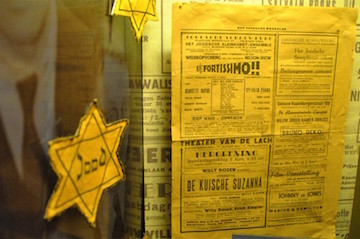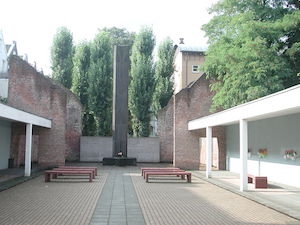Summary | Excerpt | Reading Guide | Reviews | Beyond the Book | Read-Alikes | Genres & Themes | Author Bio

This article relates to Girl in the Blue Coat
When Germany invaded The Netherlands in May 1940, few could have imagined the horrors that would follow, including the murder of about three-quarters of the estimated 140,000 Jews living in the country before the war. Almost as soon as occupation began, resistance groups formed to oppose German dictates.
 When Ollie, a central character in Monica Hesse's Girl in the Blue Coat, takes Hanneke, the main character, to a group meeting, she discovers that the college students work to disrupt German rules, help procure limited rations for those in hiding, and smuggle babies to safety from the nursery next to the Schouwburg deportation center. While Ollie's group is not named, their actions are similar to those of a real organization known as the Amsterdam Student Group.
When Ollie, a central character in Monica Hesse's Girl in the Blue Coat, takes Hanneke, the main character, to a group meeting, she discovers that the college students work to disrupt German rules, help procure limited rations for those in hiding, and smuggle babies to safety from the nursery next to the Schouwburg deportation center. While Ollie's group is not named, their actions are similar to those of a real organization known as the Amsterdam Student Group.
According to the Dutch Resistance Museum, two students, Jan Meulenbelt and Rut Matthijsen, from Utrecht University, some 40 miles from Amsterdam, developed a system of hiding places for Jewish children. These two students worked with two others in Amsterdam to form the principal members of the Amsterdam Student Group. By smuggling children out of the nurseries next to makeshift deportation centers like the Schouwburg Theatre, the group helped save more than 400 children from Hitler's death camps.
 The Hollandsche Schouwburg website explains that the theatre was once a place for leisure and entertainment. However, "Starting in 1941, the same Hollandsche Schouwburg became a place of exclusion and isolation. Under orders from the German occupying force only Jewish artists were allowed to perform there to exclusively Jewish audiences. Ten months later, it became the waiting room of death. In the heart of the capital, where Jews had lived and worked for centuries, more than 46,000 Jewish individuals - innocent men, women and children - were detained and then deported in plain sight. They went unknowingly, and often with great dread, to meet almost certain death in notorious concentration camps such as Auschwitz, Sobibor, Bergen Belsen, and Theresienstadt."
The Hollandsche Schouwburg website explains that the theatre was once a place for leisure and entertainment. However, "Starting in 1941, the same Hollandsche Schouwburg became a place of exclusion and isolation. Under orders from the German occupying force only Jewish artists were allowed to perform there to exclusively Jewish audiences. Ten months later, it became the waiting room of death. In the heart of the capital, where Jews had lived and worked for centuries, more than 46,000 Jewish individuals - innocent men, women and children - were detained and then deported in plain sight. They went unknowingly, and often with great dread, to meet almost certain death in notorious concentration camps such as Auschwitz, Sobibor, Bergen Belsen, and Theresienstadt."
Doing what they could to help save lives, the Amsterdam Student Group removed children from the deportation nurseries and sent them to safe places. The Dutch Resistance Museum website states that the work was quite dangerous. The website also highlights how it was decided where the children would be sent: "There were four different groups involved in this resistance work. Each of the groups had their own addresses, mainly in the provinces of Friesland and Limburg. As many of the blond children as possible were sent to Friesland, while those with dark hair were sent to Limburg, where they would be the least conspicuous."
 In recent years, the Hollandsche Schouwburg has been turned into the Netherlands' National Holocaust Museum, to honor those who risked their lives in resistance to terrorist rule and to remember those who died during the atrocities of World War II.
In recent years, the Hollandsche Schouwburg has been turned into the Netherlands' National Holocaust Museum, to honor those who risked their lives in resistance to terrorist rule and to remember those who died during the atrocities of World War II.
Hollandsche Schouwburg in Amsterdam.
Part of the displays at the Dutch Resistance Museum.
Filed under People, Eras & Events
![]() This "beyond the book article" relates to Girl in the Blue Coat. It originally ran in May 2016 and has been updated for the
April 2017 paperback edition.
Go to magazine.
This "beyond the book article" relates to Girl in the Blue Coat. It originally ran in May 2016 and has been updated for the
April 2017 paperback edition.
Go to magazine.
Censorship, like charity, should begin at home: but unlike charity, it should end there.
Click Here to find out who said this, as well as discovering other famous literary quotes!
Your guide toexceptional books
BookBrowse seeks out and recommends the best in contemporary fiction and nonfiction—books that not only engage and entertain but also deepen our understanding of ourselves and the world around us.